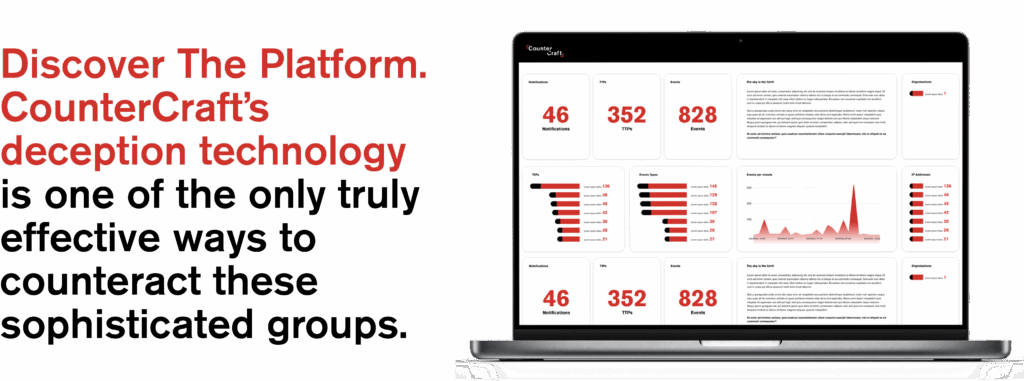APTs are highly-skilled. persistent, disciplined, and now powered by AI. CounterCraft’s deception platform flips the script in Advanced Persistent Threats and cybersecurity, using believable decoys and automated telemetry capture to detect APTs during the recon phase, before any real damage is done. This blog breaks down how deception changes the economics of detection and fuels preemptive cybersecurity, turning attacker behaviors into actionable threat intelligence across multi-cloud environments.
From SolarWinds to Volt Typhoon, the threat to cybersecurity from Advanced Persistent Threats (APTs) isn’t just theoretical; it’s active, global, and often invisible until it’s too late. But what if you could watch the attackers from step one, with them never even knowing?
While APTs are still the most sophisticated threat to systems today, their playbook has remained much unchanged over the last decade. What has changed is the speed at which they can recon your network, supercharged today by generative AI and massive exploit libraries. The good news? You can flip that asymmetry on its head. By turning your environment into a minefield of high-fidelity decoys, deception technology lets security teams see APT operators before they breach, extract their TTPs in real time, and steer them away from the data that matters.
Why are they called “Advanced”?
Attack groups like Sandworm or APT29 operate more like well-funded startups than shadowy wizards. They set KPIs, track success metrics, and, critically, reuse tooling that still works.
“You can use the all-singing, all-dancing AI exploit, or you can just use the same old tricks that have served you well before,” says CounterCraft Product Specialist Richard Barrell. “Old hacks from 20 years ago still work, and pros know it.”
In other words, “advanced” refers to the entire infrastructure and process behind these actors, not just cutting-edge technology. They mix bleeding-edge zero-days with legacy exploits, living-off-the-land binaries, and social engineering. That makes detection at the reconnaissance layer mission-critical.
Deception, when done well, exploits that assumption of trust. By mimicking authentic business operations and digital assets, it offers believable hooks to guide adversaries into controlled environments.
What are the biggest challenges security teams face with APTs?
Before an APT ever exfiltrates data, they have to quietly navigate your network, usually undetected. For security professionals, the twin challenges in this scenario boil down to two crucial questions:
- Are my controls, people and processes enough to stop a motivated, well-resourced crew?
- How fast can I see them, quantify the risk, and shut the door to prevent data exfiltration?
The real risk isn’t just a breach; it’s the time it takes to notice one. Most endpoint tools only raise flags after privilege escalation or successful lateral movement, by which point attackers have already gained significant ground.
Deception flips that script entirely. Instead of waiting for red flags, it lays out a map of irresistibly realistic, instrumented assets across your network, decoys that behave just like the real thing but instantly alert the moment they’re touched.
This approach doesn’t just shorten detection windows; it transforms how risk is surfaced and understood. In one recent deployment, a stealthy APT actor was identified within 12 hours of their initial scan, long before any traditional endpoint tool flagged lateral movement. Their reconnaissance behaviors, tool signatures, and network paths were all captured before real damage could occur. That’s the power of forward visibility and real-time adversary engagement.
Learn from some of our case studies on how organizations report dramatic drops in attacker dwell time.
1. Are my controls, people and processes enough to stop a motivated, well-resourced crew?
2. How fast can I see them, quantify the risk, and shut the door to prevent data exfiltration?
How does AI-powered recon impact APT cybersecurity defenses?
Generative AI has changed the recon game for Advanced Persistent Threats in cybersecurity. Today’s APTs can simulate user behavior, map your entire digital terrain in seconds, and identify high-value weak points, all without tripping a single alarm in traditional security stacks.
“AI-driven recon isn’t just fast, it’s methodical,” says Barrell. “Attackers now run entire test campaigns across cloned environments to see which exploits will yield results.”
Deception technology meets this escalation with equal sophistication, allowing defenders to scatter lifelike credentials, endpoint artifacts, and even SaaS tokens across their environment, each one wired to instantly trigger alerts when touched.
But the real magic lies in the telemetry. When an attacker interacts with a decoy, you’re not just alerted, you’re given a roadmap of their priorities, tools, and workflows. “We’re harvesting their playbooks before they’ve even moved laterally,” says Barrell. “That’s intelligence collection at its best.”
The result? High-confidence IOCs, precise TTP mapping, and even behavior-based attacker profiles, delivered before production systems are compromised. Instead of chasing shadows, your SOC sees the whole attacker lifecycle unfold in a controlled space. Rather than reacting to alerts, you gain curated intelligence authored by the adversary themselves, and that flips the entire detection model from reactive to predictive.
What makes CounterCraft different?
CounterCraft’s deception platform is one of the only truly effective ways to counteract these sophisticated groups. Rooted in real-world intelligence gathering, its architecture is designed to meet the always-changing tradecraft of APTs head-on, giving warfighters and organizations the tools they need to proactively and preemptively defend. And CounterCraft’s decoy environment and lure realism is second to none.
But what makes deception so uniquely effective against today’s most persistent threats? And how does it work in complex, modern environments?
Let’s break it down:
How can deception technology reduce APT dwell time?
CounterCraft’s platform is designed for minimal lift and maximum output. With AI-powered asset generation and automated deployment wizards, security teams can spin up complex, context-aware deception campaigns in minutes, not days. Every decoy is automatically monitored and managed by the system, so analysts focus only on high-confidence, high-context signals.
Why is realism essential in cybersecurity deception?
From industrial OT environments to multi-cloud SaaS estates, any digital asset credentials, documents, endpoints, or even tokens, can become a deception artifact. These aren’t static honeypots; they’re dynamic, responsive assets embedded with behavioral scripts and system-level realism, making them virtually indistinguishable from production infrastructure. This level of detail ensures attackers engage, providing richer, higher-fidelity intelligence.
Start broad to catch unknown scans, then concentrate on specific hotspots revealed by early intel. This layered approach keeps APTs chasing ghosts while your SOC secures the real crown jewels.
How does deception scale across multi-cloud and OT systems?
Whether it’s blanketing an entire enterprise cloud environment with wide deception coverage or embedding deep deception focused on flushing out a malicious insider, CounterCraft allows teams to deploy both tactics simultaneously, and even shift between them in real time. This adaptability is critical for defending against multi-vector APT campaigns.
How does deception deploy across cloud providers?
Customers can auto-deploy deception hosts across AWS, Azure, and Google Cloud Platform (GCP).. This means multi-cloud organizations gain complete flexibility and scale across their entire infrastructure. No blind spots, no manual heavy lifting.
Fighting Advanced Persistent Threats in cybersecurity
APTs aren’t invincible; they’re operationally efficient. Matching that efficiency with deception means you regain initiative, see attackers sooner, and control how the story ends.
Here are some top tips for flipping the script:
- Assume automation. Seed their scanners with believable decoys designed to lure, not just delay.
- Monitor everything. A decoy that doesn’t alert is just a fancy fake; instrumentation is non-negotiable.
- Exfiltrate attacker telemetry in real time. Feed your SIEM/XDR with actual TTPs, not signatures.
- Use deception to measure risk. Don’t just tell the board you’re secure; show them how attackers would try to move.
- Automate the snapback. Link deception alerts to SOAR playbooks for rapid, precision response.
You can’t stop APTs from probing. But you can control the map they see and turn their curiosity into your visibility. Ready to see deception in action? Request a demo of the CounterCraft The Platform.
About the Author
Richard Barrell
Product Specialist, CounterCraft
Richard Barrell is Product Specialist at CounterCraft and has been in charge of guiding product development of The Platform from MVP to the present day. Richard is also responsible for managing strategic projects in multiple industry and government sectors. You can find him on LinkedIn.



